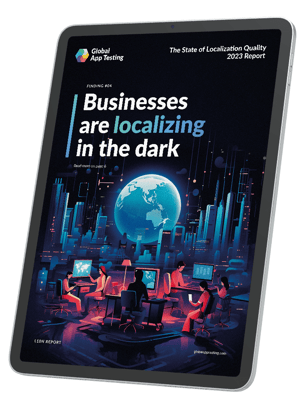Report
Get the 2023 State of Localization Quality Report
Link without forms:
Download the full report (pdf)
Whats in the report?
In the Global App Testing State of Localization Quality Report we surveyed hundreds of localization professionals to identify how localization quality is evolving in 2023.
From the changing budgets and data approaches to the creep of AI mass-applied to translations, we're looking at localization from the ground up.
Here's what you'll find out:
1️⃣ Activities and budgets in localization - including what kind of team has a growing budget and why
2️⃣ Localization data approaches - how, and to what extent, do businesses use data to inform their localization efforts around the world.
3️⃣ Localization challenges – what are other teams struggling with? What are some solutions they suggest?
We've shared more detail below:

How to build a great localization strategy
If you’re thinking about moving into new markets, how much thought have you given to your localization strategy? It can be extremely easy to get pulled into being an in-house translation agency and forget to set a strategic agenda.
We’re going to be looking at what a localization strategy entails and how to develop one that helps your business make the right kind of impact.
In the spring of 2023 we asked 150+ L10n and I18n professionals about their thoughts on quality.
We wanted to find out if global businesses were taking localization seriously enough. Is quality improving, or declining? What's the driving force behind either outcome? Team structure? A better or worse budget? More or limited data?What are the frustrations felt across teams and are there any notable trends driving change in the industry (aside from our obvious friend: AI) that we can share with the community? The responses reveal some fascinating results - one of which which we could write a whole book on, and is highlighted on our report cover: many businesses - no matter what their size - localize in the dark.
What do we mean by "Localizing in the Dark"? Head to page 6 to find out.
Establishing your localization strategic framework
A special mention to one of our localization partners in crime: Lokalise.
As a popular and credible TMS solution to the industry, the Lokalise team helped us in our quest to learn about L10n quality and what it means in today.
Don't miss what Alex, an experienced product lead at Lokalise, and Ronald, our co-founder and best-selling author of Leading Quality, have to say on the findings on pages 10 - 11.
We found out some surprising results
Activities & Budget
| 1 | Translation is King, but not by much (p4) UI changes (51%) were almost as common a L10N activity as translations (61%), which was lower than expected. |
| 2 | Budgets are stagnant as expectations rise (p4-5) 57% of respondents increased their focus on L10N last year; but budgets were most likely to remain flat (46%).x faster go-to-market time and better l10n delivery. |
| 3 | Measure your impact to grow your budget (p5) It sounds obvious, but only 14% of teams who didn’t measure their impact managed to grow their budgets. Teams measuring app downloads are more likely to see their budget increase. |
Localization Data
| 4 | Many teams localize in the dark (p6) The largest cohort (40%) of respondents said they did not know what impacted their local NPS and revenue, even when targeted on NPS. |
| 5 | Data is hardest when it’s needed quickly (p7) 54% agreed “getting timely local feedback” was more important than “isolating drivers of poor performance” as a challenge. |
| 6 | Data may be the key to localization maturity (p7) 79% of teams who “strongly agree” that they have data for decision making also identify as high- or medium-to-high maturity. |
Localization Challenges
| 7 | Cross-functional L10N is tough (p8) 69% of respondents identified cross-functional working in their top #3 internal challenges, making it the most popular pain point. |
| 8 |
Speed affects quality across the board (p9) |
| 9 | UX matching context is the hardest problem (p9) 69% of respondents identified it in their top #3 internal challenges, making it the most popular challenge. |

